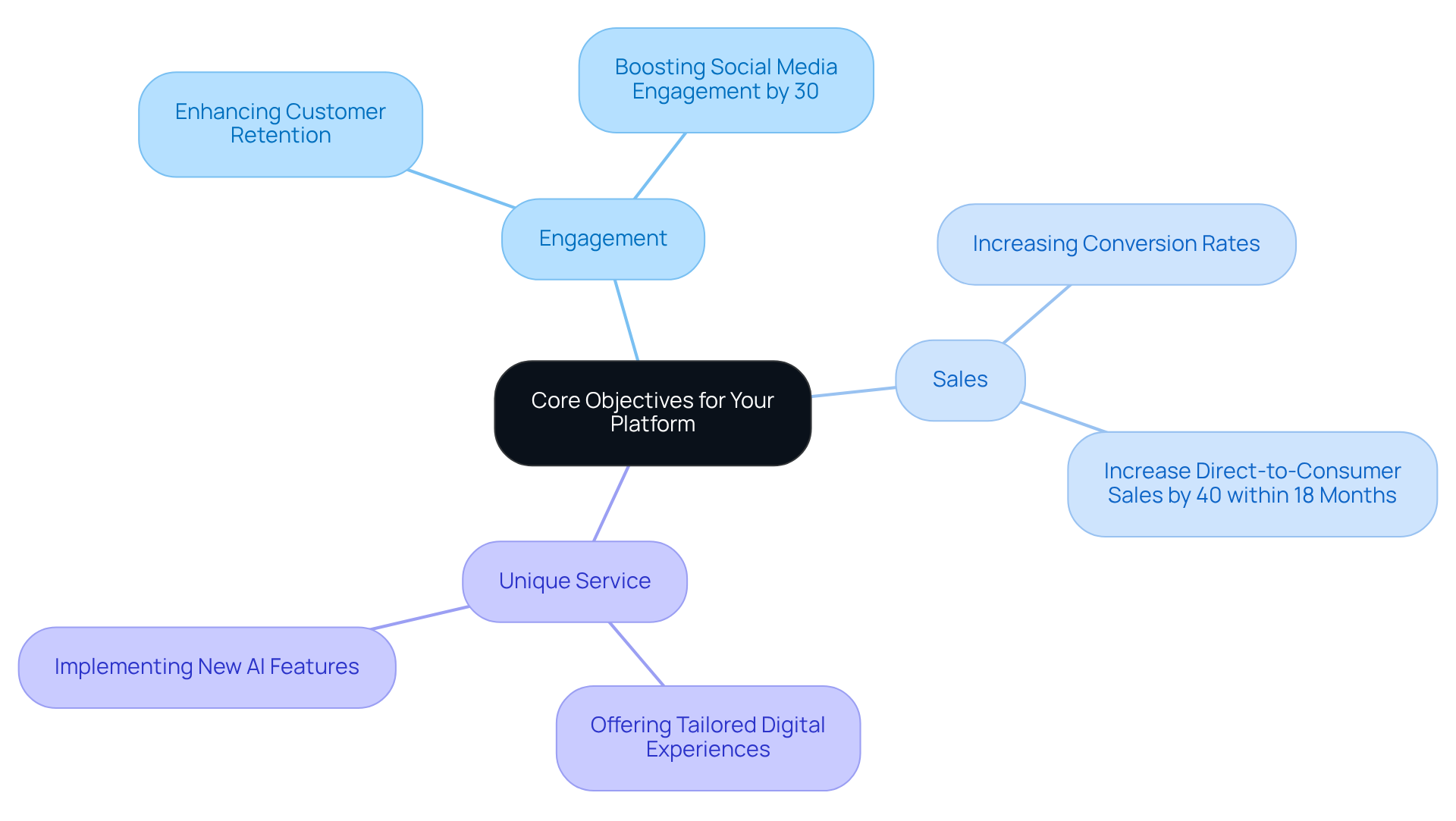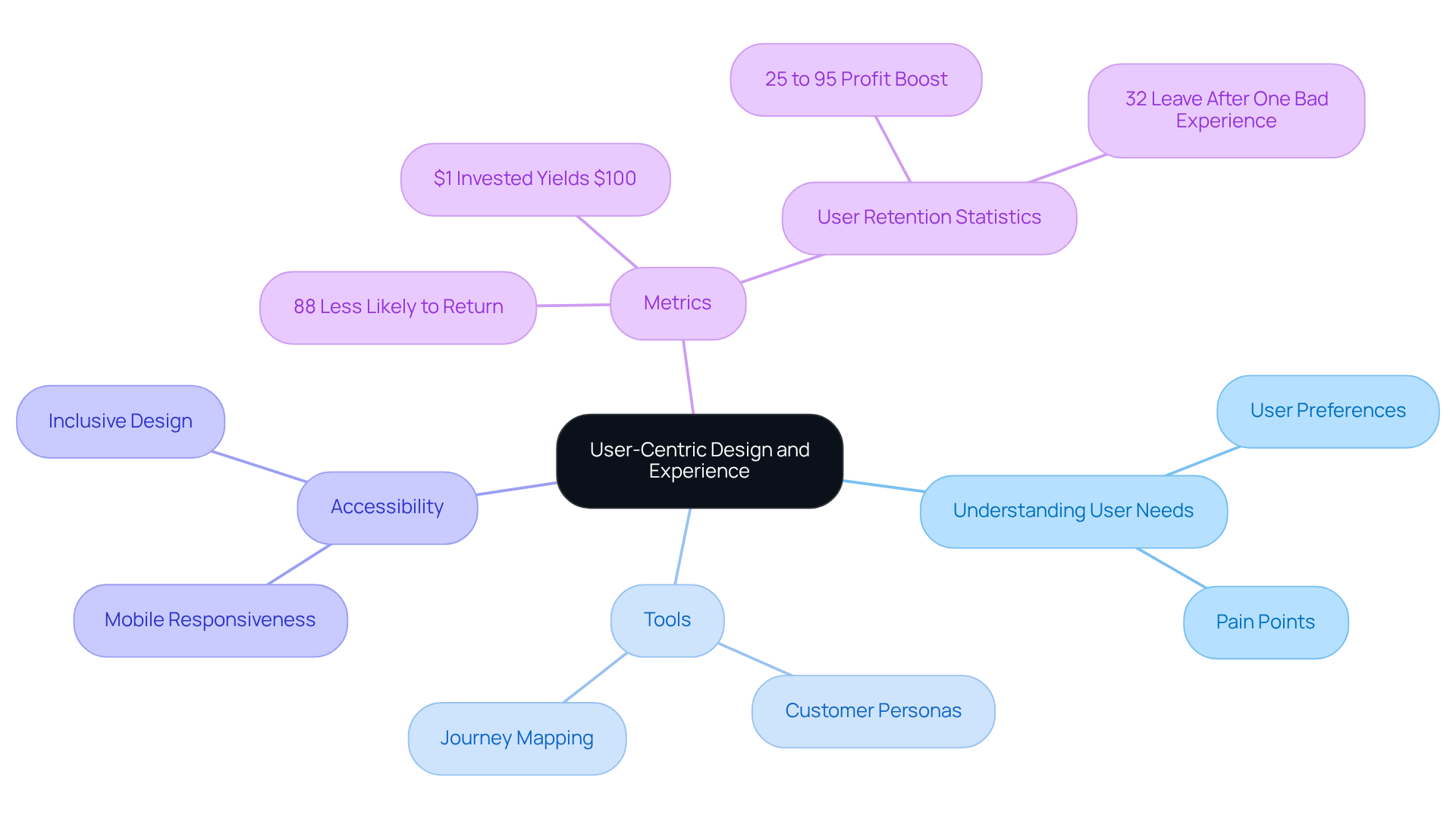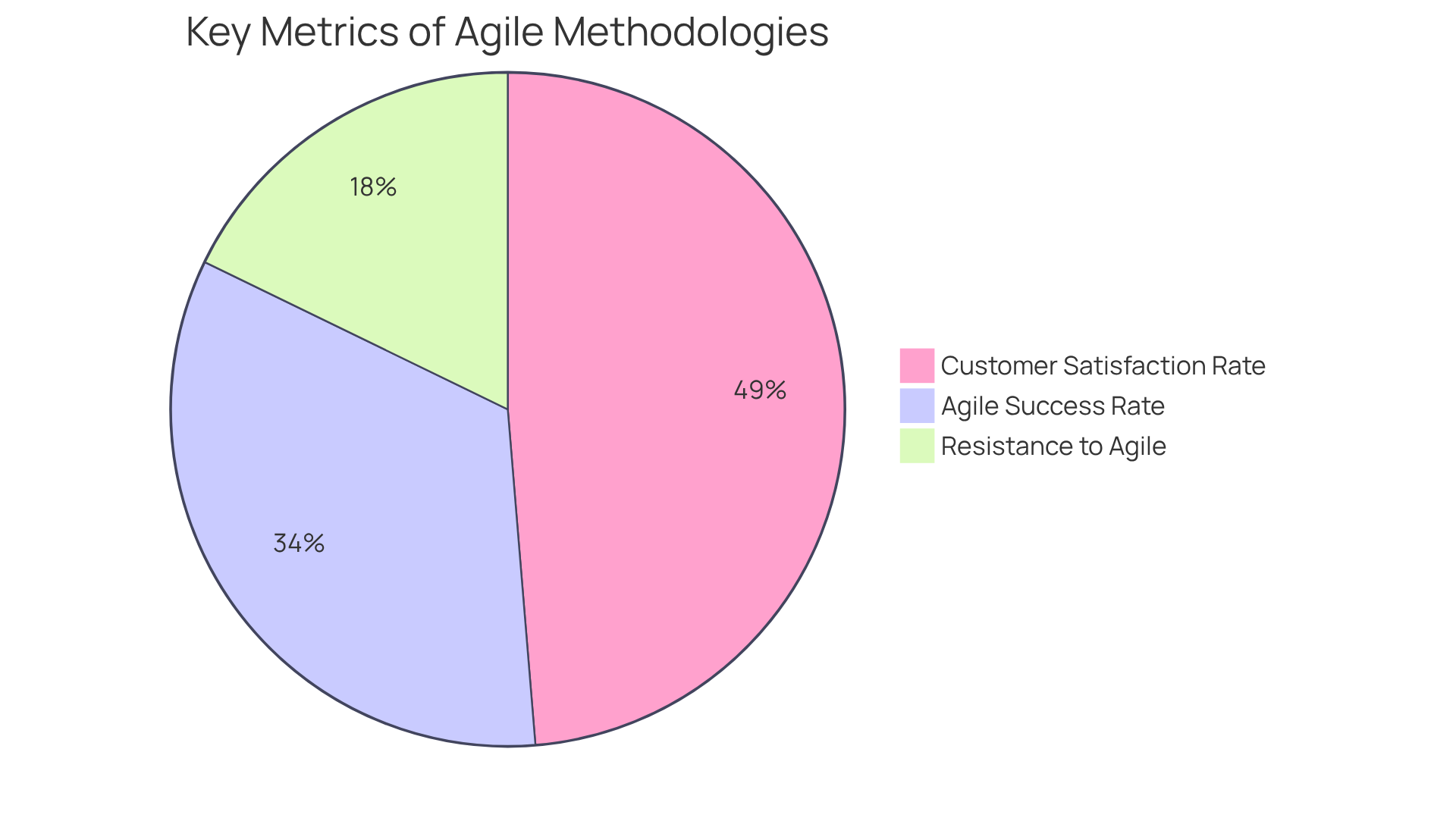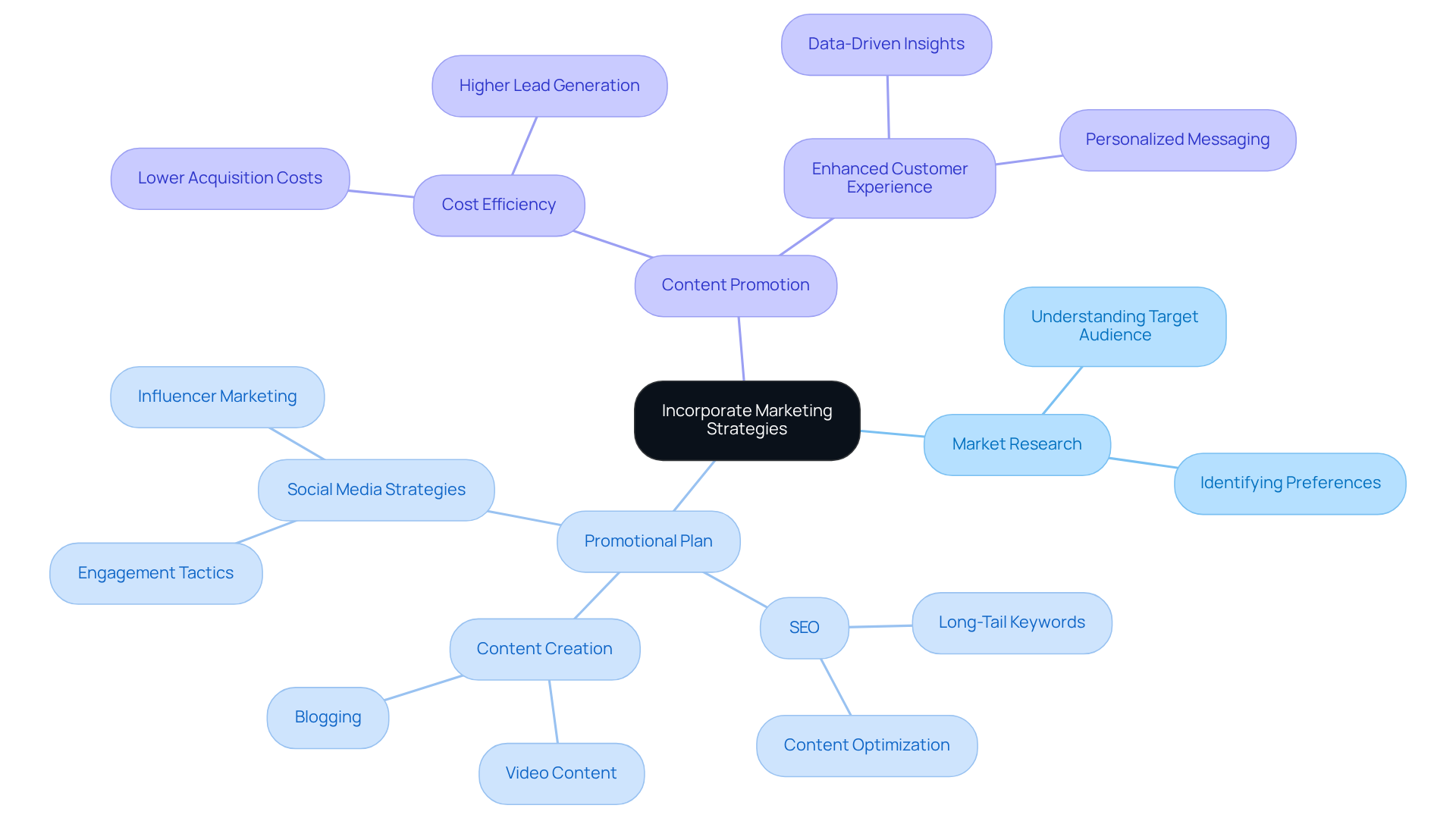Overview
In the journey of tech startup founders, achieving success with platforms and applications can often feel overwhelming. Many struggle with:
- Defining clear objectives
- Designing with users in mind
- Adopting agile practices
- Integrating marketing strategies from the outset
This can lead to frustration and missed opportunities, affecting both development and user engagement.
However, there is hope. By establishing core objectives that are guided by SMART goals, founders can create a clear path forward. Prioritizing user-centric design allows for feedback to be leveraged through agile methods, ensuring that the product truly meets the needs of its users. Furthermore, incorporating marketing efforts from the very beginning enhances visibility and reach, creating a more robust foundation for success.
These four key practices—setting objectives, focusing on users, embracing agility, and marketing effectively—are not just strategies; they are essential pillars that support a thriving platform and application. By nurturing these practices, founders can foster an environment where both development and user engagement flourish, paving the way for a successful venture. Remember, you are not alone on this journey; the right support and strategies can make all the difference.
Introduction
In today’s competitive landscape, crafting a successful platform or application can feel overwhelming for many founders. It’s not just about having innovative ideas; it’s about navigating a complex web of best practices that can make or break your venture.
Establishing clear objectives is essential, but so is prioritizing user-centric design. Implementing agile development methodologies and integrating marketing strategies from the outset can greatly enhance your chances of success.
However, we understand that aligning team efforts and truly grasping user needs can be daunting challenges. How can you effectively bridge these gaps to ensure that your platform not only launches successfully but thrives in the long run?
Let’s explore these concerns together, as there are supportive strategies available to help you on this journey.
Establish Core Objectives for Your Platform
To achieve success, it's essential to start by clearly identifying the of your platform and application. Are you hoping to improve engagement, increase sales, or offer a unique service? Recognizing these objectives creates a roadmap for your development team, guiding them through the journey.
For instance, a tech startup in the eCommerce sector might find it crucial to focus on:
- Increasing conversion rates
- Enhancing customer retention
By employing SMART criteria—Specific, Measurable, Achievable, Relevant, and Time-bound—you can refine these objectives, ensuring they are not only actionable but also trackable.
It's important to consistently review and adjust these goals based on client feedback and market trends, allowing them to align with your overall business strategy. This iterative approach not only fosters ongoing improvement but also enhances the efficiency of the platform and application in meeting needs and supporting growth.
Remember, you're not alone in this process; many founders share similar challenges, and together, we can navigate the path to success.

Prioritize User-Centric Design and Experience
To attain success in platform and application development, it’s essential to embrace a user-centric approach. Many founders face the challenge of truly understanding their target audience's needs, preferences, and pain points. This understanding is the cornerstone of effective design. By conducting thorough research, you can lay a solid foundation that resonates with individuals. Tools like customer personas and journey mapping can help , ensuring that every aspect of the system connects meaningfully with users.
For instance, consider how a successful application might use A/B testing on various layouts to discover which design fosters greater engagement. This highlights the vital role of iterative design processes that allow for ongoing testing and feedback.
Accessibility and mobile responsiveness are not just features; they are paramount. Both platform and application must be inclusive and functional across a variety of devices. Imagine the frustration of users—88% of individuals are less likely to return to a site after a poor experience, and 40% will leave if a website takes more than three seconds to load.
Prioritizing user experience is not merely beneficial; it’s crucial for attracting and retaining visitors. Furthermore, every $1 invested in UX design can yield a remarkable return of $100, showcasing the financial benefits of prioritizing user experience. Current trends in experience research underline the increasing significance of personalization and data-driven insights, which can greatly enhance user retention and satisfaction. By focusing on these aspects, tech startups can create systems that not only draw individuals in but also keep their interest alive over time.

Implement Agile Development Practices
Many tech startup founders encounter challenges when adopting Agile methodologies like Scrum or Kanban. This transition can often feel daunting, as resistance within organizations can create significant hurdles. The implications of not embracing these frameworks can be profound; without collaboration and transparency, teams may struggle to manage their projects effectively. However, there is a nurturing solution available. Agile methodologies foster a culture of iterative progress, allowing teams to break projects into manageable sprints. This structure encourages regular evaluations and modifications based on participant feedback, creating a supportive environment for growth.
For instance, consider a tech startup that decides to launch a minimum viable product (MVP). This approach not only accelerates time to market but also ensures that the final product aligns closely with client expectations. By encouraging cross-functional teams to collaborate, innovation and problem-solving flourish throughout the development cycle. It’s heartening to note that organizations utilizing Scrum report a remarkable 250% improvement in product quality, showcasing the framework's effectiveness in driving successful outcomes.
Moreover, Agile projects boast a higher success rate of 64% compared to Waterfall projects, and Agile practices have been shown to enhance customer satisfaction rates by 93%. This underscores the immense value of incorporating user feedback at every stage of development. Yet, it’s crucial to acknowledge that 34% of organizations face , which can indeed pose challenges during implementation. As one industry leader insightfully stated, 'Agile focuses on customer feedback at every stage,' reinforcing the importance of this nurturing approach. By embracing Agile, you can foster a supportive environment that not only addresses these challenges but also cultivates a thriving culture of collaboration and innovation.

Incorporate Marketing Strategies from the Start
From the outset, it's essential to weave promotional strategies into the development of your system. Many founders struggle with understanding their target audience and their preferences, which can lead to frustration and missed opportunities. Conducting market research can illuminate these insights, helping you create a thorough promotional plan that integrates SEO, content creation, and social media strategies tailored specifically for your audience. For instance, a tech startup might find success in launching a blog that addresses common pain points within their industry, ultimately driving organic traffic to their platform.
Content promotion can be a game-changer, producing up to three times more leads at a 62% reduced cost compared to conventional outbound methods. This makes it an incredibly cost-efficient approach for startups. It's important to employ analytics tools to monitor client behavior, allowing you to adapt your promotional efforts accordingly. In fact, 61% of campaign leaders affirm that enhanced data significantly improves customer experience.
By harmonizing your marketing strategies with your system's development, you can cultivate a unified brand presence that resonates with users and enhances engagement. However, be mindful of common pitfalls, such as neglecting to regularly review and adapt your strategies, as this can hinder the success of your platform and application. Remember, you're not alone in this journey; many founders face similar challenges, and together we can toward a thriving future.

Conclusion
Establishing a successful platform and application can feel overwhelming, especially when faced with the myriad of challenges that tech startup founders encounter. It’s essential to have a clear understanding of core objectives, user-centric design, agile development practices, and integrated marketing strategies. By defining specific goals, you can create a structured roadmap that guides your development efforts. This clarity not only enhances your decision-making but also aligns your team toward a common purpose, ultimately driving success.
Prioritizing user experience is vital, and employing tools like customer personas and journey mapping can help you truly understand user needs. Implementing agile methodologies fosters a culture of collaboration and responsiveness to feedback, which leads to higher product quality and customer satisfaction. Moreover, incorporating marketing strategies from the outset ensures that your promotional efforts resonate with user expectations, creating a stronger brand presence.
The journey to platform and application success is indeed multifaceted, requiring a blend of strategic planning, user-focused design, and agile methodologies. As you navigate this path, embrace these best practices and continuously adapt to user feedback. Integrating marketing efforts throughout the development process can empower you to overcome the challenges of the tech landscape. By doing so, you can cultivate products that not only meet but exceed user expectations, paving the way for sustainable growth and success. Remember, you are not alone in this journey; there is a community ready to support you every step of the way.
Frequently Asked Questions
What is the first step to achieving success with a platform and application?
The first step is to clearly identify the primary goals of your platform and application, such as improving engagement, increasing sales, or offering a unique service.
Why is it important to recognize the objectives of a platform?
Recognizing the objectives creates a roadmap for the development team, guiding them through the development journey and ensuring alignment with overall business strategy.
What are some examples of objectives for a tech startup in the eCommerce sector?
Examples of objectives include increasing conversion rates and enhancing customer retention.
What criteria can be used to refine objectives?
The SMART criteria—Specific, Measurable, Achievable, Relevant, and Time-bound—can be used to refine objectives, making them actionable and trackable.
How should objectives be managed over time?
Objectives should be consistently reviewed and adjusted based on client feedback and market trends to ensure they remain aligned with the overall business strategy.
What is the benefit of an iterative approach to managing platform objectives?
An iterative approach fosters ongoing improvement and enhances the efficiency of the platform and application in meeting needs and supporting growth.




